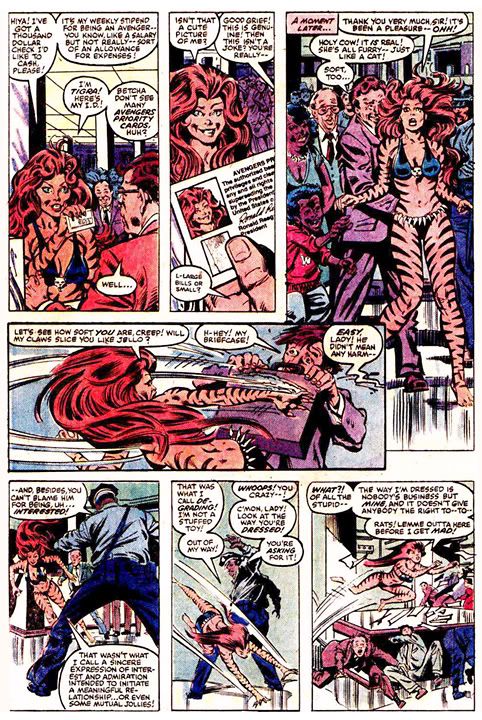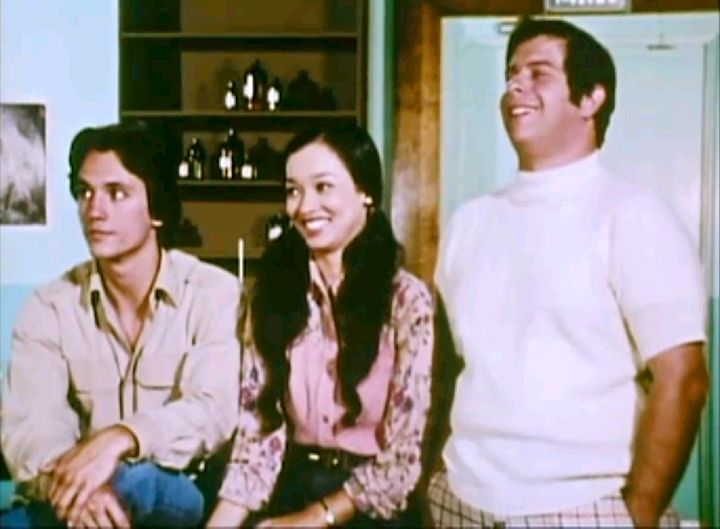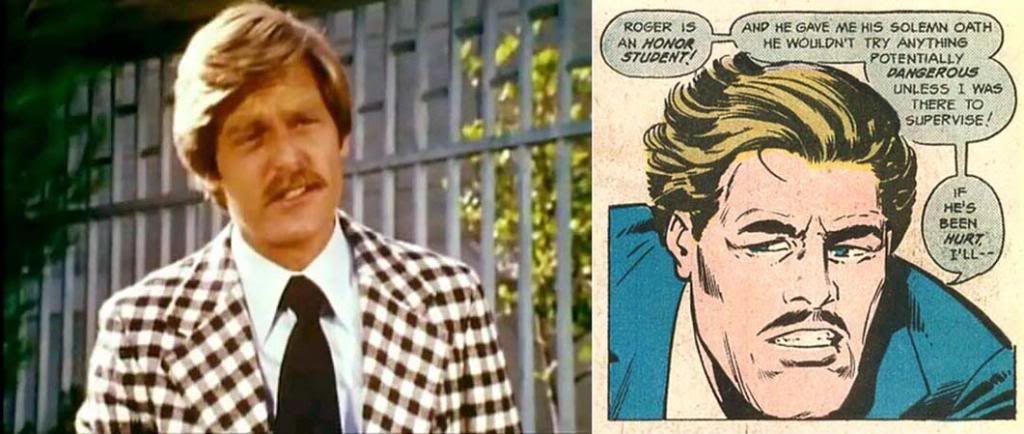First of all, let me say... I
really wanted the Columbia Ten-Speed Formula 10 Racer. Obviously, I didn't get it. What I did get for Christmas a year later was a low-end
BMX bike, a red
Puch Challenger which I owned until just a couple of years ago. That aside, when I was 13 nothing swayed my comics buying decisions more than the cover and interior art.
This cover is by Alan Weiss:
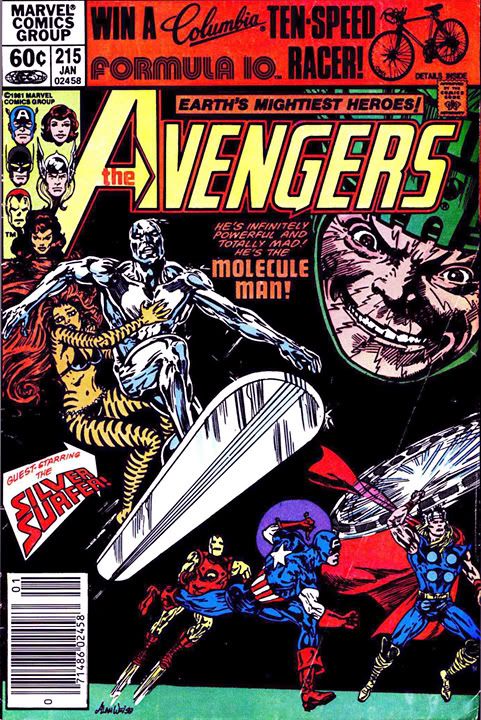
So of course I had to have it.
I think the only comics I was reading at the time were
Sgt. Rock, Micronauts,
New Teen Titans and
Uncanny X-Men. Sometimes I'd pick up another title based solely on how the art looked. And Alan Weiss's art looked pretty sweet to my
teen eyes: solid figures rendered with lots of shadow modeling to give them a solid, dimensional quality. Their awkward posing wasn't so much a problem for me then. I liked lines and lots of them. The more lines, the better, as far as I was concerned.
Marvel's famous cat-lady Tigra is the star of this Jim Shooter-scripted epic:

She'd recently joined the Avengers, viewing it mainly as a lark, a chance to be a superhero superstar. In the previous issue,
Avengers #214 (December 1981), the Avengers go west to fight Ghost Rider, and
Tigra uses it primarily as an excuse to buy sexy cowgirl-wear. When the heroes confront Ghost Rider,
Tigra promptly chickens out.
In "All the Ways of Power,"
Tigra seems much more at home with the extra-curricular trappings of being a Marvel hero than she does with the job itself. She loves the generous stipend and status as a semi-celebrity, even if people have trouble remembering her name and powers. Which is hardly surprising when you think about it. After all, Marvel Earth is overrun with
mesomorphic oddities from all over the galaxy. People in garish costumes teem. Oh they do teem. Tigra has a tendency to get lost in the shuffle, and people who can travel between company continuities sometimes confuse her with Catwoman.
Shooter's stories feature these amazing cosmic heroes dealing with the mundane aspects of daily life. You get the feeling at times their spandex must chafe, cause rashes or just flat-out stink from the laundry hamper. In this issue, there's an amusing scene where Dr. Donald Blake tries to figure out what to order for breakfast in an "upper west side restaurant" (that must mean something to Manhattanites), gets his Avengers signal, transforms into Thor in what's described as the "tiny men's room," and then can't figure out how to get his god-like physique through the barred window. He ends up strolling as Thor among the diners, much to his chagrin.
Still, even among all the
Norse gods, adamantium-laced bones and giant purple planet-eaters from deep space,
Tigra's public appearances as she goes about her everyday tedium tend to be pretty striking themselves:
I can understand the stares.
Tigra's a furry
catwoman in a bikini, in a bank. Even In Marvel New York, that's going to bring eyeballs a-
poppin' and jaws a-
droppin'.
There's a John Updike short story called
"A & P," about three girls who visit a
beach-side grocery store wearing only their swimsuits, before being kicked out. The
teen-aged cashier narrating the tale sees this as social injustice and quits in protest, then realizes he probably made a stupid mistake. Taking time to wear appropriate attire isn't being oppressed, it's being polite.
However, the groping is inexcusable, no matter what the security guard claims. I'm not sure the hands-on guy deserves a claw-slash, though. I want to seem him get a comeuppance, yes, but to live afterwards so he can go about his life using what he's learned. If he hadn't thrown up his briefcase in self-defense,
Tigra would have caught him in the jugular, killing him. A simple face slap would've sufficed or better yet, a surprise stomach punch. Surprise stomach punches work wonders against gropers. Air violently whistles out, nausea ensues, sometimes the victim drops to his knees. It's really cool. Unless there's puking, in which case some poor minimum wage-earner has to mop it up.
Tigra seems to understand this, but not before Weiss treats the 13-year-old audience to some cheesecake. I have to admit that in the throes of puberty, this image had a definite effect on me:

It didn't lead to a lifelong obsession with
catwomen or
furrydom or anything like that. Not my things. But neither is judging those for whom they are. Anyway, I liked it at the time. Here's where Tigra suddenly realizes she's putting on something of a show. So being a comic book female written by a dude, there's only one thing
Tigra can do at this point. Shopping spree!
Yay!

It's really cool how the off-register four-color print job provides
Tigra with a milk mustache in the bottom left panel. This prefigures the "Got Milk" ad campaign by a number of years; maybe this was its initial inspiration. I'm guessing from his characterization of
Tigra in the previous issue and this one that to Jim Shooter, she's essentially a cowardly, emotionally unstable, potentially violent shopping machine. Now fashionably attired but no less self-absorbed,
Tigra decides to spend part of her afternoon in a bar inhabited by middle-aged businessmen who have nothing better to do than while away the day drinking Harvey
Wallbangers and highballs as their Fortune 500 companies go down the toilet:

Now that's one classy guy; he uses "offbeat" as a euphemism for "potential niche-market porn star." I really don't want to know this guy's private life but I can't help but imagine it involves trying to get his female employees to accompany him on business trips to
Sybaris resorts, his suitcase packed with nothing but edible body oils and a gold lame bikini brief. In this case,
Tigra's response is completely justified, and absolutely perfect: the
ol' brass necktie.
Finding herself with nothing else to do, she hops on the subway, only to interrupt one of those New York style nuisance crimes in progress. In comics as well as in Woody Allen films, the New York subways are filled with garishly costumed punk refugees from Walter Hill's cult masterpiece,
The Warriors:

On second thought, I guess this is something of an improvement on those old Steve
Ditko Spider-Man stories from the 60s where teenagers wear bow-ties and drive jalopies right out of Archie comics, but it still looks like Alan Weiss cast his tale from the same talent pool where the casting directors of
Sgt. Pepper's Lonely Hearts Club Band and
Xanadu got their extras. At last
Tigra shows off her altruistic side, giving her Avengers stipend to some old guy. Then she throws away her newly-bought clothes (she
could've at least given them to a homeless woman or cross-dresser, huh?) and bounds away:

Shooter's point is, even superheroes must sometimes have to stand naked. Not literally, although that's almost the case with Tigra. We like to say Marvel introduced personal problems into the story mix, and Shooter takes these things to their logical extreme. Tony Stark gets hand cramps signing all those checks, Captain America may or may not have hemorrhoids. That kind of thing. Even superheroes get the blues. Watch television. Go bowling. At the halfway point,
Tigra's carefree midtown jaunt comes to an abrupt end as Silver Surfer shows up with some troubling news-- Molecule Man has set up shop somewhere in suburban New Jersey.
Shooter's story continues to present the action through
Tigra, as the audience's proxy. You can draw whatever conclusions you want about
Tigra's secondary position and awkward posture on the Surfer's board, but what's truly
magnificent here is that Captain America is riding Iron Man like a horse:

Riding Iron Man like a horse. Whatever else you might say about Jim Shooter-- and people have said a lot over the years-- you have to admit at this point we're witnessing something close to genius at work. The Avengers could have used one of their space-jets for transportation, but with three flying members versus two non-flyers on their roster, they decide on economy over ostentatious displays of technology. The always-obliging Cap hops on Shellhead and away they go.
Despite its emphasis on daily minutia, I can't call Shooter's writing realistic. There are still too many space surfers and Norse gods flying around. Naturalistic, maybe. He'd get a lot of mileage out of this sort of fantastic-mundane mash-up with his
Harbinger series, but here is its genesis. This is no doubt the truest depiction of how this situation would look in the real world if Captain America had to ride on Iron Man's back. Actually, I'm not sure who to thank for this incredible image. This could be pure Weiss. Weiss might have worked from a simple plot synopsis and interpreted something along the lines of, "The Avengers fly to the scene of the crime," with this as the glorious result, and Shooter simply took one look at the finished page a few weeks later, gave it a thumb's up and said, "Oh, hell yes! THIS is how we do it here at the House of Ideas!"
Riding Iron Man. Like a horse.
Tigra's babbling dialogue seems to draw heavily upon Sally Field's role as the talkative "Frog" in the first (and best)
Smokey and the Bandit movie. So much so, in fact, that in my mind I hear her voice as Ms. Fields's. Frog was trapped in a 1977 Pontiac
Firebird Trans Am roaring along rural highways at speeds in excess of 100 MPH with
Bo "Bandit" Darville;
Tigra is clinging to a nearly-naked metallic spaceman on a flying surfboard. We'd probably all overflow with nonsense in that Trans Am at those speeds or clinging to a nearly-naked metallic spaceman on a flying surfboard.
Once the heroes are in place, and perhaps because she has frustration and anger to work out after all her hassles that afternoon (plus her guilt at "not pulling her weight"), Tigra uncharacteristically decides to take the lead:

Go for it,
Tigra! It's probably as poorly thought through as any of her actions so far in this story, and ends up having much worse consequences. Also, at this point, tentacles make their first appearance. I suppose with a main character who's already a walking fetish, tentacles were inevitable.

I'm thinking back to that
John Updike story and wondering how he would've written "All the Ways of Power." He might have echoed Shooter's humanizing the heroes by focusing on the same kind of everyday indignities we all face, but he probably wouldn't have included the tentacles. Probably, he wouldn't have touched this material even if Marvel had provided him with a lead-lined environmental suit in which to work and some kind of remotely operated, robotic vehicle to do his typing.
Still, Mr. Updike should be aware that tentacles aren't just for fuzzy bikini-clad compulsive shoppers:
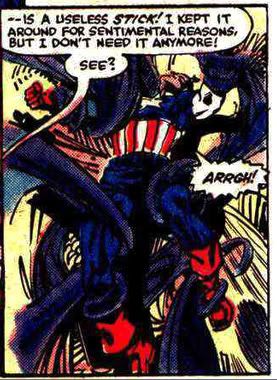
They're also for star-spangled patriots! Equal tentacles for equal work, that's the Marvel Way.
And also baroque killing machines. This is where the story reaches its emotional climax and Shooter allows
Tigra to reveal just how deep her commitment to being a hero is. Your friends are dead, only you can stop a mentally deficient madman from taking over the world, you're getting a weekly stipend you spend on designer label clothes... what do you do?

Probably not what
Tigra does here. At this point, in order to preserve our
dignity as readers, we really need just to look away and not deal with
Avengers #216 (February 1982). Yet as cringe-inducing as Shooter's version of
Tigra is at this moment, it's still not as demeaning to the character as the time
John Byrne turned her into a mentally-unstable sex freak who had to be shrunk in order to contain her. Although I'll argue neither version is less valid than any other writer's. I just doubt John Updike would characterize her the same way.



























